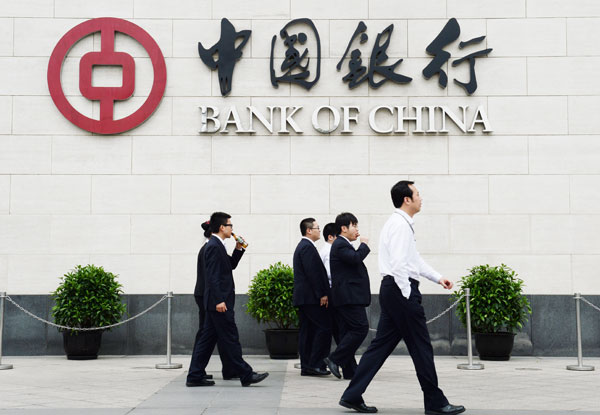Bad loans at four-year high
Updated: 2013-05-16 02:07
By Wang Xiaotian (China Daily)
|
||||||||
Total assets of banking sector grow fivefold in past decade
 |
|
The headquarters of the Bank of China in Beijing. Major State-owned banks saw their non-performing loans rise by 14.6 billion yuan ($2.37 billion) in the first three months. MARK RALSTON / AFP |
Bad loans of Chinese banks reached their highest level in four years by the end of March, according to data released by the China Banking Regulatory Commission on Wednesday, while their total assets rose by 17 percent.
Outstanding non-performing loans, or NPLs, stood at 526.5 billion yuan ($85.67 billion), up by 33.6 billion yuan from the end of 2012, while the ratio of bad loans to total lending rose by 0.01 percentage point to 0.96 percent, during the first quarter of the year.
Total assets of the banking sector stood at 141.3 trillion yuan, meaning total banking assets have increased by 113.6 trillion yuan, or fivefold, in the past decade.
Bloomberg reported the figures also mean that bad loans have now increased for a sixth straight quarter - the longest deterioration streak in at least nine years.
The CBRC added that the provision coverage ratio for bad loans fell to 291.95 percent by the end of March, from 295.51 percent three months earlier.
Shang Fulin, its chairman, warned the bad loan levels are likely to continue rising among banks.
The soured-loan increases were reported across all categories, including State-owned lenders, joint stock banks and regional banks in cities and rural areas.
Major State-owned banks experienced the biggest jump, as their NPLs rose by 14.6 billion yuan during the quarter. Their ratio of such loans to total lending dropped by 0.01 percent to 0.98 percent.
Joint stock banks reported the biggest increase in their NPL ratio, by 0.05 percent to 0.77 percent, while the amount of their bad loans went up by 9.9 billion yuan.
Guo Tianyong, director of the Research Center of the Chinese Banking Industry at the Central University of Finance and Economics, said: "The rise in non-performing loans is a natural result of economic slowdown, with increasing defaults among companies, especially small and medium-sized enterprises."
However, he suggested the current increase in soured loans was still mild, and the amount may decrease in the following months, as the economy stabilizes.
An Ernst & Young report, released on Tuesday, also said that the banks' "increasing momentum to lend to SMEs for higher returns" had led to increasing credit risks, and how to fend off bad loans from this sector "has become a challenging task".
Jimmy Leung, PwC's banking and capital markets leader for China, said banks should now write off more bad loans using their profits, and put more efforts into collecting loan repayments.
The CBRC figures showed that bank profitability had declined as domestic economic growth slowed to 7.7 percent in the first quarter, and the government continued attempts to liberalize interest rates.
Net interest margins, a major measurement of profitability from traditional deposits and lending, narrowed to 2.57 percent in the first quarter among 3,800 lenders, from 2.75 percent at the end of 2012, it said.
Income based on the interest rates accounted for around 80 percent of the total income of Chinese banks last year, according to CBRC figures.

 Michelle lays roses at site along Berlin Wall
Michelle lays roses at site along Berlin Wall
 Historic space lecture in Tiangong-1 commences
Historic space lecture in Tiangong-1 commences
 'Sopranos' Star James Gandolfini dead at 51
'Sopranos' Star James Gandolfini dead at 51
 UN: Number of refugees hits 18-year high
UN: Number of refugees hits 18-year high
 Slide: Jet exercises from aircraft carrier
Slide: Jet exercises from aircraft carrier
 Talks establish fishery hotline
Talks establish fishery hotline
 Foreign buyers eye Chinese drones
Foreign buyers eye Chinese drones
 UN chief hails China's peacekeepers
UN chief hails China's peacekeepers
Most Viewed
Editor's Picks

|

|

|

|

|

|
Today's Top News
Shenzhou X astronaut gives lecture today
US told to reassess duties on Chinese paper
Chinese seek greater share of satellite market
Russia rejects Obama's nuke cut proposal
US immigration bill sees Senate breakthrough
Brazilian cities revoke fare hikes
Moody's warns on China's local govt debt
Air quality in major cities drops in May
US Weekly

|

|







